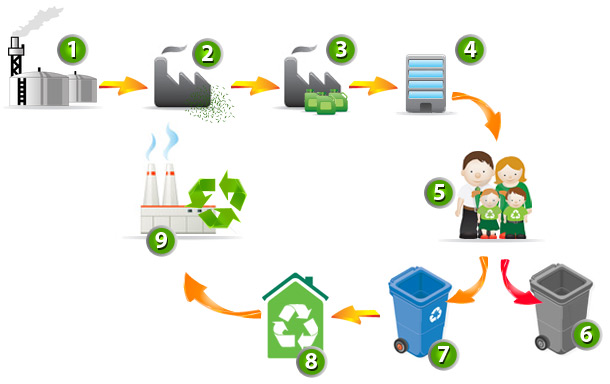Recycling
What happens to the packaging once we use its contents? It generally ends up as waste the moment we empty its contents or when certain purchased goods are unpacked.
An interesting and unlaudable fact is that the amount of waste produced daily is about 2 kg per capita on the entire planet. This is a worrying calculation that makes us conclude that it is necessary to change the habits in production-consumer relations. Also, it is necessary to adapt to modern development tendencies and to treat waste more responsibly.
Certain types of waste, such as PET bottles, plastic bags or cans, have a very long decomposition time (see table below). This kind of waste is a major polluter on the planet, and recycling is a method by which we can mitigate it.

The term recycling means the conversion of waste material into a new product and its reuse, which contributes to the reduction of environmental pollution, energy and natural resources savings.
When it comes to PET packaging, the further recycling process consists of pressing (baling) the packaging waste, transporting it to the processing plant and unbaling. If the separation was not carried out before the baling, the PET bottles are separated by colors at this stage, and then further processed until the level of the final product that is re-marketed and used.
Waste collection is performed by municipal (public or private) companies, mainly in containers. When there are no waste collection containers at the waste collection point, we are talking about unsorted waste that is taken to landfills for further treatment. Unsorted waste is difficult to dispose of due to the diversity of waste, which is therefore decomposed by different dynamics.
| Material | Decomposition period |
| Food, flowers, organic products | 1-2 weeks |
| Paper | 10-30 days |
| Cotton clothes | 2-5 months |
| Wood | 10-15 years |
| Tins, cans | 100-500 years |
| Plastic, PET bottles, bags | From a few hundred to a thousand years |
| Glass bottles | Never |
Sorted waste collection means the collection and sorting of waste into containers intended for a particular type of waste (for example, containers for PET packaging, metal, paper, glass). This type of waste collection is also called primary selection and is the most ideal for further recycling because such waste collection makes the waste least dirty.
Proper selection of PET packaging in the household implies that the interior of the empty PET bottle is rinsed with water, the cap is removed, and the air is expelled from the bottle. This type of bottle is easier to treat in further processing and takes up less space in storage containers, thus increasing their capacity.
